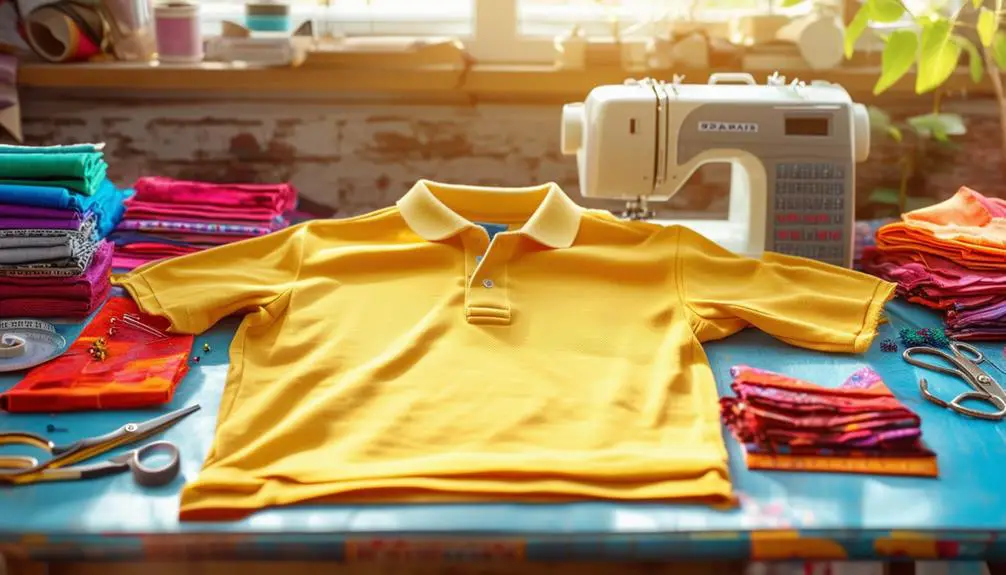To tailor a vintage polo shirt, start by trying it on to pinpoint areas needing adjustment, such as the sides and sleeves. Measure the chest and waist, subtracting 1-2 inches for a fitted look. Gather sharp scissors, a sewing machine, pins, and matching thread. Lay the shirt flat, mark cutting lines with fabric chalk, and cut carefully. Use a sewing machine with a ballpoint needle to stitch seams, pressing them after for a polished finish. Remember to preserve the shirt's vintage character by retaining original details. There's more to mastering this craft that can elevate your tailoring skills even further.
Assessing the Fit
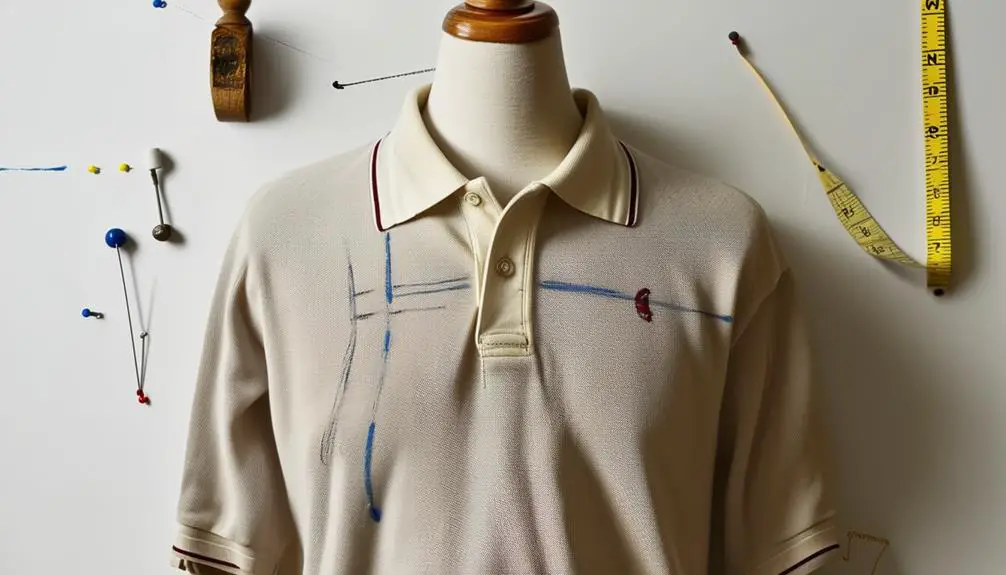
When it comes to tailoring a vintage polo shirt, evaluating the fit is your first step toward achieving a polished look. Start by trying on the shirt to identify areas of excess fabric, especially around the sides, back, and sleeves. These areas often indicate where tailoring is needed.
For example, vintage pieces from brands like Betty Barclay often feature unique silhouettes that may require special attention. Take measurements of key sections like the chest, waist, and length to gauge how much fabric you'll need to remove for a better fit.
Next, pay close attention to the shoulder seams. They should sit comfortably without drooping or pulling, as this affects the overall appearance and fit of the shirt.
For those vintage Ralph Lauren polo shirts, verify the sleeves are fitted but not overly tight. You want to maintain ease of movement while still looking sharp.
Also, assess the sleeve length and width carefully. A well-fitted sleeve can elevate the shirt's overall look.
Gathering Necessary Tools
Equipping yourself with the right tools makes tailoring a vintage polo shirt a smoother process. Start by gathering scissors for cutting fabric; sharp ones will make clean, precise cuts.
Next, you'll need a reliable sewing machine to stitch seams together, guaranteeing durability in your alterations. Choose thread that matches your shirt's color to achieve a seamless finish, as this attention to detail will enhance the overall appearance.
Understanding the identifying vintage characteristics of your polo can also provide guidance on maintaining its authenticity during tailoring.
Pins are your best friends—use them to secure fabric edges before sewing. They keep everything in place, preventing any shifting during the alteration process.
Don't forget fabric chalk or markers; these help you clearly mark measurements and cutting lines without damaging the fabric. A measuring tape is essential, letting you take accurate measurements of the shirt and determine how much fabric to remove for a better fit.
Lastly, keep an iron handy. After sewing, pressing seams helps achieve a polished look and guarantees your alterations hold their shape.
With these tools at your side, you're ready to transform that vintage polo into a perfect fit!
Measuring for Adjustments
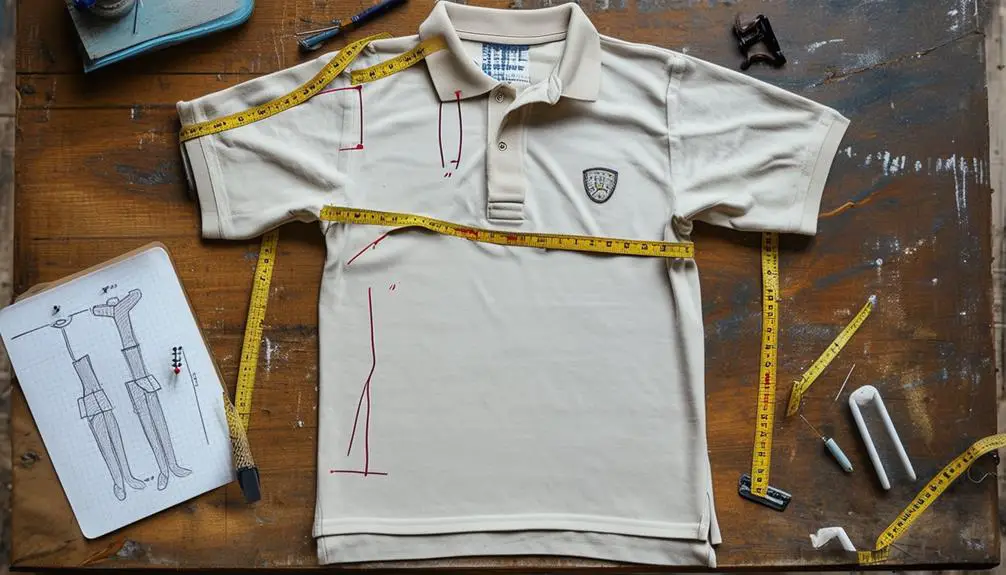
Measuring for adjustments is essential to achieving the perfect fit for your vintage polo shirt. Start by laying the shirt flat and smooth to guarantee accurate readings.
Grab a measuring tape and focus on these key measurements:
- Chest Width: Measure across the shirt's chest, then subtract 1-2 inches for a slimmer fit, based on your preference.
- Waist Width: Similar to the chest, measure the waist width and apply the same subtraction to achieve that tailored look.
- Shoulder Width: Measure from seam to seam to see if the shoulders need adjustment for comfort.
Next, don't forget to check the sleeve length. Measure from the shoulder seam down to where you want the sleeve to end, usually around your wrist.
If you're shortening, keep in mind how much fabric you'll need to remove.
Cutting the Fabric
Cutting the fabric of your vintage polo shirt is an essential step in achieving that tailored look you're aiming for. Start by laying the shirt flat on a clean, sturdy surface. This guarantees an even cutting area and helps avoid distortions in the fabric. Next, grab some fabric chalk or a fabric marker and mark your desired cutting lines. Make sure you measure and double-check for accuracy before making any cuts.
Once you're satisfied with your marks, carefully cut through the fabric along the lines. Keep a steady hand to achieve even cuts and prevent fraying. If you're shortening sleeves or the hem, make certain your cuts are straight and parallel to the original hemline to maintain the shirt's aesthetic.
Remember to save the cut fabric pieces; they can be handy for patching or other DIY projects later.
| Step | Action |
|---|---|
| 1. Lay the shirt flat | Guarantee a clean, sturdy surface |
| 2. Mark cutting lines | Use fabric chalk or marker |
| 3. Measure carefully | Double-check for accuracy |
| 4. Cut along lines | Maintain a steady hand |
| 5. Save cut pieces | They might be useful for future projects |
Sewing Techniques
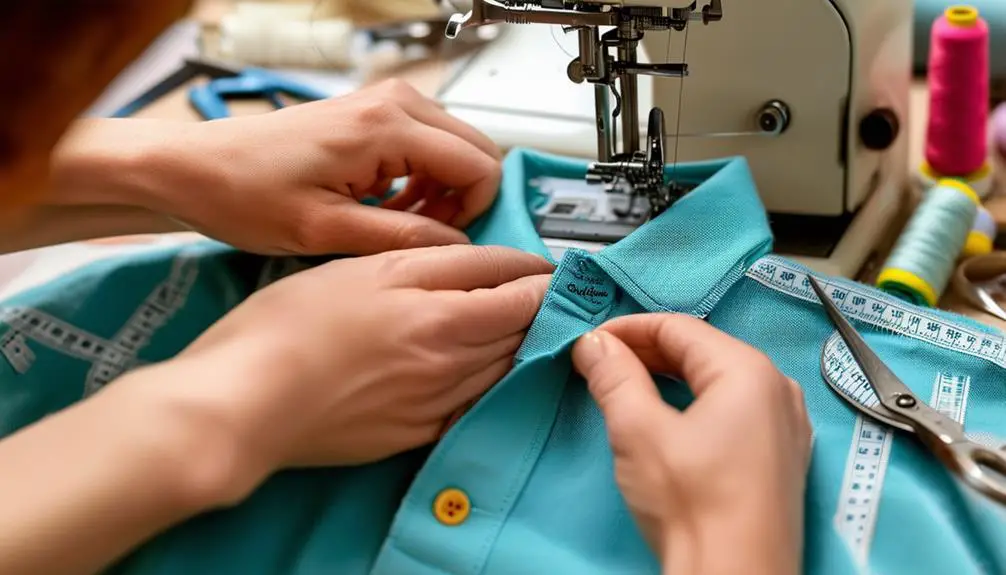
Sewing your vintage polo shirt can truly elevate its fit and style, giving it a personalized touch that stands out. Using the right techniques is vital to guarantee a clean and professional finish.
Start by choosing a sewing machine equipped with a ballpoint needle. This helps prevent snagging the knit fabric, allowing for smooth stitching.
Next, opt for either a straight stitch or a zigzag stitch. These choices provide some stretch in the seams, which is essential for maintaining the shirt's original shape after your alterations.
Finally, consider these three important steps:
- Mark with Fabric Chalk: Always mark your alterations before cutting. This guarantees precise measurements that respect the shirt's design.
- Use a Serger or Overlock Stitch: This technique on raw edges prevents fraying and enhances durability, keeping your shirt looking sharp.
- Press Seams with an Iron: After sewing, pressing seams flat not only achieves a polished look but also helps the fabric lay beautifully.
With these techniques, your vintage polo shirt will have a tailored fit that showcases your unique style!
Finishing Touches
The finishing touches on your vintage polo shirt can make all the difference in achieving a polished, professional look. Start by trying on the shirt after your alterations. This guarantees a comfortable fit and allows you to make any necessary adjustments before finalizing the seams.
Once you're satisfied, it's wise to wash and dry the tailored shirt again. This step confirms that your adjustments hold and the fabric maintains its shape. Additionally, consider the history of your shirt; understanding its vintage tag significance can enhance your appreciation for the garment.
Next, grab your iron and press the seams to remove any wrinkles from the alteration process, giving your shirt that crisp appearance. If you want to elevate your shirt's style, consider adding embellishments like embroidery or patches. These personal touches can enhance its vintage appeal and make it uniquely yours.
Preserving Vintage Character

After achieving that polished look with your tailored vintage polo shirt, it's important to focus on preserving its unique character. The charm of a vintage piece lies not just in its style but also in its history. Here are some essential tips to keep in mind:
- Retain Original Stitching: Keep the original stitching and hem styles intact. This helps maintain the shirt's historical authenticity and enhances its vintage appeal.
- Use Similar Thread: When making alterations, opt for thread colors and types that match the original. This guarantees that any adjustments blend seamlessly with the existing fabric, preserving the overall aesthetic.
- Avoid Altering Unique Elements: Don't touch unique design features like embroidered logos or distinctive patterns. These elements are what make your vintage polo shirt special, contributing to its allure.
Additionally, document the shirt's original fit and features before starting any work. This way, you can refer back to its original state, assuring the vintage essence remains respected throughout the process.
Seeking Professional Help
When it comes to tailoring a vintage polo shirt, finding the right professional can make all the difference. You want someone experienced in working with knit fabrics to maintain the shirt's integrity. The right tailor can help you achieve that perfect fit while preserving the vintage charm.
Here's a quick overview of what to evaluate:
| Criteria | Details | Cost Range |
|---|---|---|
| Tailor Expertise | Look for those who specialize in menswear and vintage pieces. | $10 – $15 per shirt |
| Alteration Types | Common adjustments include side seams and shortening sleeves. | Varies by complexity |
| Local Options | Many dry cleaners offer tailoring services at competitive prices. | $10 – $15 per shirt |
| Preparation | Bring specific ideas and know your desired fit to communicate effectively. | Free consults often |
Before your appointment, articulate your vision for the shirt. Whether you want a fitted look or a more relaxed style, clarity will help the tailor deliver the results you expect. With the right professional by your side, your vintage polo shirt can be tailored to perfection.
DIY Vs. Tailoring Services
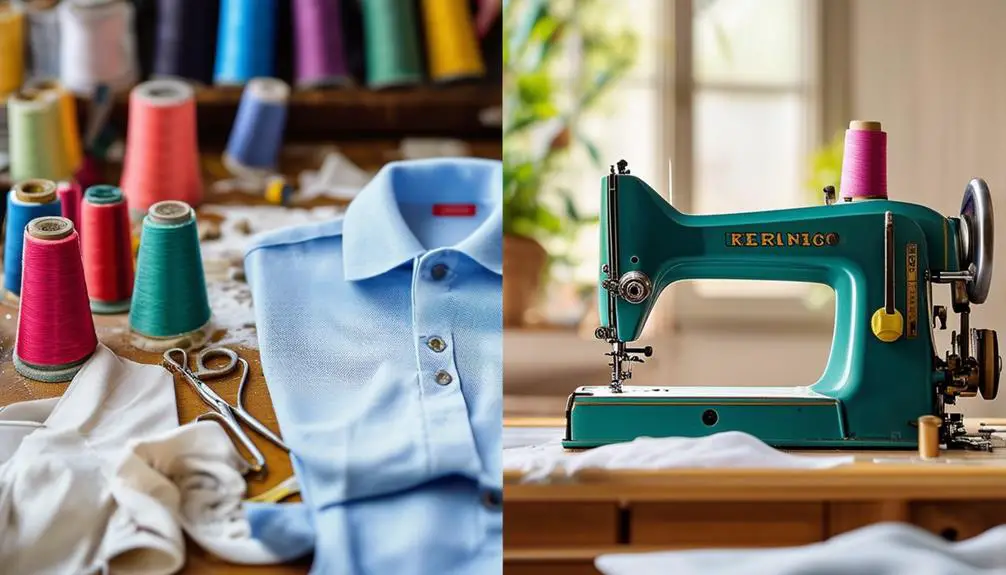
Finding the right approach to tailoring your vintage polo shirt can be a game-changer.
You'll want to weigh your options carefully between DIY alterations and professional tailoring services. Each route offers distinct advantages, so consider the following:
- Cost-Effectiveness: DIY alterations can save you money if you have basic sewing skills. You can adjust the fit for under $15, while tailoring services typically charge around $10 to $15 for similar adjustments.
- Quality of Fit: A skilled tailor provides a polished, precise fit, especially for high-end vintage polos. They can address complex fit issues and maintain the original hem style, something that might be challenging to achieve on your own.
- Time and Effort: DIY may seem appealing, but it requires practice and patience. You mightn't see immediate results without some experience, while tailoring services usually offer a consultation to assess your preferences and guarantee a satisfactory outcome.
Ultimately, whether you choose DIY or professional services, understanding the pros and cons can help you tailor your vintage polo shirt to perfection.
Caring for Your Tailored Polo
Caring for your tailored polo is essential to preserving its fit and fabric quality over time. To keep it looking sharp, always machine wash it in cold water and tumble dry on low. This simple step prevents shrinking and protects the fabric from damage.
Avoid ironing or dry cleaning your polo, as these methods can compromise its integrity and finish, leaving you with a less-than-perfect garment.
When it's time to store your polo, fold it rather than hanging it up. This helps maintain its shape and prevents stretching at the shoulders, ensuring it retains that tailored look.
Regularly inspect your polo for signs of wear and tear—loose threads or seams can quickly turn into bigger issues if left unaddressed. Catching these little problems early will greatly extend the life of your beloved shirt.
For those inevitable stains, don't panic! Spot clean with a gentle detergent and water, but remember to test it on an inconspicuous area first.
Frequently Asked Questions
Can a Polo Shirt Be Tailored?
Yes, you can tailor a polo shirt for a better fit. Adjusting side seams and sleeve lengths enhances your look, while DIY alterations save money. Just confirm shoulder fit is right before making changes.
How Do You Feminize a Polo Shirt?
To feminize a polo shirt, take in the side seams for a tailored fit, shorten the sleeves, and add decorative elements like lace. Pair it with skirts or fitted trousers for a stylish look.
Do Classic Polo Shirts Shrink?
Yes, classic polo shirts can shrink, especially cotton ones. They typically shrink 5-10% after the first wash. To minimize this, wash in cold water and air dry instead of using a hot dryer.
Can Ralph Lauren Shirts Be Altered?
Yes, you can alter Ralph Lauren shirts to improve fit. Whether you need side seams taken in or sleeves shortened, a skilled tailor can help maintain the shirt's quality while enhancing its overall silhouette.
